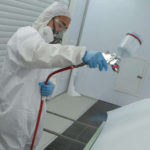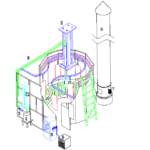Powder coating has high production efficiency, excellent coating performance and eco friendly advantages, has been widely used in the world with a 10% yearly growth rate. By ensuring the appearance of powder coating film and mechanical properties, the most concerned is consumption of powder coating, that is, the production costs, so powder coating loading rate is common concern from both manufacturer and end user.
The principle of electrostatic powder coating
Electrostatic powder coating is the use of high-voltage electrostatic corona electric field. Spray gun needle connected to the high-voltage negative (generally 60 to 100kV), workpiece is grounded to form a positive pole, so between the spray gun and workpiece there’s a strong electrostatic field. when the powder coating is sent from the powder supply barrel to the spray needle through the powder tube, because it is connected to the high voltage negative electrode to generate corona discharge, a dense negative charge is generated near it, so The powder is negatively charged and enters the electrostatic field with high electric field strength. Under the dual action of the electrostatic force and the driving force of the compressed air, the powder evenly flies to the surface of the grounded workpiece to form a uniform powder layer, which is then heated and cured to transform into a coating film.
The powder loading rate generally refers to the coverage efficiency of powder spraying. From its spraying principle, the main adsorption force of electrostatic spraying is electrostatic force. The powder loading rate mainly depends on how much the powder particles are charged. According to Coulomb’s law, increasing the charge capacity of powder particles can increase the powder coating rate.
Factors affecting powdering rate
1- Powder particle size
The charge amount of the powder is proportional to the square of the powder particle size. Increasing the powder particle size will increase the powder charge amount and increases the powder loading rate. On the contrary, reduces the powder size and reduces the charge amount, then the powder loading rate decreases. Therefore, in the process of powder coating application, small particle size powder coatings (10μm) should be reduced as much as possible; however, the particle size should not be too large. It is possible that because the gravity of the large-particle powder exceeds aerodynamic and electrostatic forces, the powder coating will fall down before reaching the surface of the workpiece due to gravity during the flight, which will reduce the powder loading rate. Therefore, controlling powder particle size is one of the key issues of powder coating quality.
For powder coatings suitable for electrostatic spraying, the particle size should be controlled at 20~90μm.
2- Dielectric constant
The charge amount of the powder is proportional to the dielectric constant of the powder. Choosing a coating component with a higher dielectric constant can increase the charge amount of the powder particles, greatly increase the powder adsorption force and increase the powder loading rate.
2.1 Coating formula
Powder coatings are mainly composed of polymer compounds such as epoxy powder and polyester powder. These polymer compounds have high dielectric constants, so their Coulomb force (electrostatic force) is relatively large, and the powder loading rate is relatively high. However, due to its relatively high price, some powder manufacturers reduce the cost of raw materials, add too many fillers, reduce the ratio of pigment to base, and greatly reduce the powdering rate of the powder in order to meet the needs of market competition.
2.2 The use and storage conditions
Comparing to solvent-based coatings, powder coatings are prone to slight orange peel. Therefore, in order to pursue the smooth and flat surface of the workpiece, many powder coating manufacturers try to reduce the powder particle size within allowable range to increase the leveling property and achieve a better coating effect. But the finer the powder, the easier it is to absorb moisture. The hygroscopicity (water content) of the powder coating directly affects the dielectric constant of the powder. Slight moisture absorption will affect its charging performance, reduce the powder loading rate and fluidity etc., so that the coating film is not smooth, and even difficult to adsorb on the workpiece. The coating film will produce bubbles and pinholes and block the gun; if the powder is severely hygroscopic, it will agglomerate and cannot be sprayed.
Therefore, in order to improve the powder loading rate, the following measures can be followed:
(1) The compressed air system must be configured with a dryer to reduce the water content of the compressed air as much as possible;
(2) Pay attention to the working area humidity. Every 30% change in relative humidity is equivalent to 2 orders of magnitude change in the resistivity of the powder. Air conditioner is suggested in the powder spraying room;
(3) The warehouse maintains air circulation, and the powder coating packaging box should be placed on a wooden board isolated on the ground, and the stacking height should not exceed 4 layers.
2.3 Spraying conditions
2.3.1 Static voltage
The charge amount of the powder coating is proportional to the electric field strength. Therefore, increasing the static voltage and increasing the charge amount of the powder is beneficial to the improvement of the powder loading rate.
The adhesion of the powder increases rapidly with the increase of the static voltage. When it reaches 90kV, the adhesion change is not obvious, so it is more appropriate to control the powder spraying voltage at 60~90kV in production.
2.3.2 Distance between spray gun and workpiece
When the static voltage is determined, the electric field strength is inversely proportional to the distance between the electrodes. When the distance between the spray gun and the workpiece is too short, spark discharge will occur; if the distance is too far, the powder loading rate will decrease. When the static voltage is controlled at 60~90kV, the electrostatic spraying distance is more suitable between 250~350mm.
Conclusion
The powder loading rate is a technical index determined by many factors. The powder spraying process is not just a fixed parameter, each manufacturer has its own standards. In addition to the main factors discussed above, there are other factors such as the sprayed workpiece surface property, the type of spray gun, and the performance of the recovery system, which will affect the powder loading rate, it requires continuous exploration and research in production.




